

Project «Voices of Jewish settlements. Vitebsk region.»פיתוח קשרי התרבות בין העמים של ישראל ובלרוס
|
|---|
Website search |
|
MainNew publicationsContactsSite mapVitebsk regionMogilev regionMinsk region |
«KADISH» IN GLUBOKOYE The Etkins in a museum in Glubokoye. Photo taken in 2009.
The Etkins in a museum in Glubokoye. Photo taken in 2009.
Two brothers were standing in front of a memorial dedicated to Jewish residents of the ghetto in Glubokoye, executed by fascists. They were saying a memory prayer. In one of these ditches lie the remnants of their relatives: the Etkins and the Kaminskys. I cannot say how many generations of these families used to live in Belarus but they spread their roots here: started families, gave birth to children, built homes, mills and dreamt about the future of their descendants. And even in the worst nightmare they could not imagine that there would come a day when all of this would be taken away from them. Mihael Etkin was the only one to survive from the whole family. He can tell the story of the tragedy of his family and all the European Jews. Mihael Etkin escaped from the ghetto. At that time he was ten. He fought in a partisan detachment; then lived in an orphanage in Vilnius. Later he moved to France and in the end - to Israel. He studied, worked and started a family. He has five children, thirteen grandchildren and a great-grandson. Mihael always wanted to come to Belarus, see the country, where his ancestors lived and where he spent his early life. He wanted to find out what had happened to his mother, where her grave was. 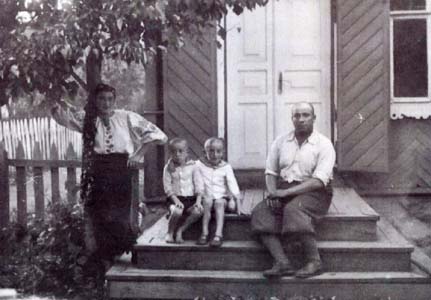 House in Krulevshizna. Photo of the family in front of the house.
House in Krulevshizna. Photo of the family in front of the house.
As soon as Glubokoye district was liberated in 1944, Mihael Etkin started looking for his mother – Eva Kaminsky. He hoped that she was alive and looking for him. Once, he met a soldier, who asked him: “Are you Eva Kaminsky’s son?” Then he added: “Your mother was a heroic woman.” He said nothing else, so Mihael did not know what actually had happened to her. Mihael wrote a letter to a newspaper in Glubokoye, asking if anyone remembered Eva Kaminsky, a partisan nurse. There were no answers. The staff of the Belarusian Embassy in Israel found out about Mihael and decided to help him. They received a letter from the Belarusian archives: Eva Kaminsky was executed by fascists in Dokshitsy together with other partisans. Mihael, despite health problems, made up his mind to come to Belarus. … He had a twin brother, Haim. One of Mihael’s sons is called Haim now. He came to Belarus together with his father. Mihael’s mother originated from Glubokoye, father – from Krulevshizna. His name was Menahem-Mendl Etkin. They owned a mill and a saw-mill. Even though mother also had a good job, working as a nurse in a hospital in Glubokoye, they decided to live in Krulevshizna. So Eva took a train to work every day. 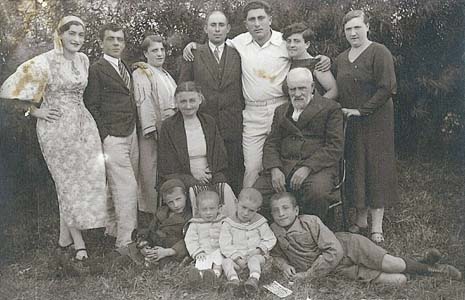 The Etkins. Standing from left to right:
The Etkins. Standing from left to right:Eva (Hava) Kaminsky-Etkin, father’s uncle Hanoh Etkin, his wife, Hanon Perevoskin (aunt Rahel’s husband), Boma Kabakov (cousin, who came from Israel to visit the family), father’s aunt Rahel Etkin. Sitting: grandmother Haya-Liba Kabakova and grandfather Saul-Rafael Etkin. At the bottom, from left to right: Mike (Zelik)Hodosh (father’s cousin), my father Mihael Etkin, his twin brother Haim-Shepse Etkin and Greg Hodosh (Mike’s brother). Photo taken in 1935. Mihael Etkin did not come to Belarus in the end. He died in February, 2009. His plan was carried out by his sons Haim and Menahem. They came to Belarus with their wives and one son. In Krulevshizna they found the place where their house once stood, where the mill and the saw-mill were located. Of course, that place was different and nothing showed that it had gone through the war. Then there was a trip to Dokshitsy. Archive documents mention that here, on the central square, there was a gallows, where fascists hanged partisans, where they also hanged the nurse Eva Kaminsky. Dokshitsy does not have a Jewish cemetery. Old matseivas were scattered in a place, where Jews were once buried. Several years ago a symbolic Jewish cemetery was made by American Jews, whose roots originated in Dokshitsy. The matseivas were collected and set up in one area, which was fenced. The Etkins set up “a virtual memorial” to Eva Kaminsky in the same area. 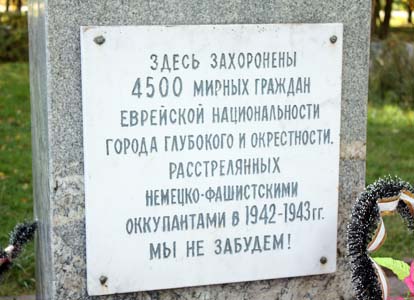
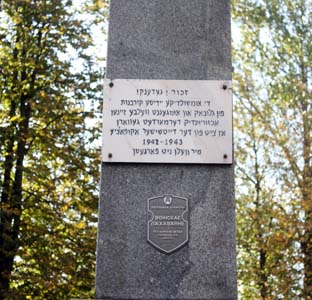 Memorial at the place of liquidation of Glubokoye ghetto. Photo taken in 2009.
Memorial at the place of liquidation of Glubokoye ghetto. Photo taken in 2009.
Mihael often told his children and grandchildren about the country they had never been to. Many things sounded odd to them, but when they grew up, they understood his feelings. He especially loved talking about his mother, who was a widow with two small children. Her husband died at the age of 32 in 1941. Of course, the big family helped her raise the children. When Nazis came to Krulevshizna and Glubokoye, life changed abruptly. In October 1941 Germans and local policemen deported all the Krulevshizna Jews to the ghetto in Glubokoye. Eva decided not to wait for better times – she joined a partisan detachment and left her two sons with sister Leya. In August 1943, when the liquidation of the Glubokoye ghetto began, Leya was with her two nephews, not knowing what to do. She was not as decisive as her sister. Mihael tried to convince her to escape but she would not agree: “We will have the same fate as everyone else.” Then Mihael dashed in the direction of the forest. He was wounded on the leg and fell down. Fortunately, a man named Motka helped him. He took him to the forest and put bandage on the wound. Mihael had to walk from village to village and beg for food and lodging. A Belarusian family sheltered him in one of the villages. Mihael tried to find them after the war but failed. The family took care of Mihael and treated his wound. Once Germans entered the house and saw the boy on the bed. They asked who he was. The family said he was ill with typhus and it was dangerous to approach him. They claimed the boy was their worker. The Germans left the house immediately. It was dangerous to stay in the village and Mihael was sent to a partisan brigade. 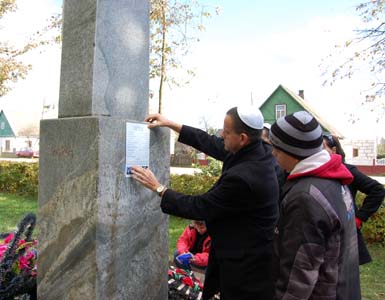 Attachment of a memorial tab to all the executed members
Attachment of a memorial tab to all the executed members of the Etkin family. Photo taken in 2009. I met the Etkins in Glubokoye. We came to the memorial, dedicated to the people, executed in the ghetto. Mihael’s daughter-in-law, Mazal, read a letter, which they wrote to Eva Kaminsky. 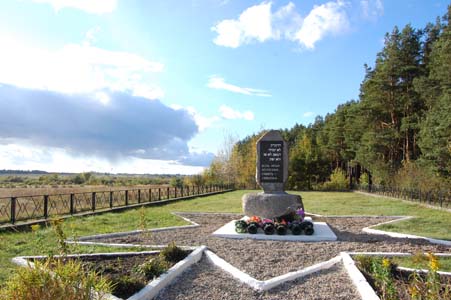 Memorial at the place of liquidation of Glubokoye ghetto.
Memorial at the place of liquidation of Glubokoye ghetto. Photo taken in 2009. “We never knew you personally and never heard your voice. Only owing to Mihael, who told us a lot about you, we remember your name. Only the two photographs, which we have, show your beautiful face. One of the photographs was made in front of your house, where you are with your husband and the two boys. Mihael often remembered that day, the house, even the smell of the apples from the orchard. Following your duty, you joined the partisans, leaving the children with the sister. Your profession showed you the way and became your destiny. You realized that you had to fight and help people. Mihael always wanted to be with you. You were aware of that and once wrote him a letter: “Dear son! I will meet you one day. This happy moment is sure to come.” We want to tell you the story of your family, which followed. Your son survived the war. He was helped by kind people. He lived in an orphanage, a repatriates’ camp and ended up in Israel. There he built a house, started a family and raised children. Until the end of his life he continued looking for you. He did not manage to do it; that is why we are here. Please, forgive us that we have not found your grave… We are here to share this story with the following generations.” The Etkins and Glubukoye are separated by thousands of kilometers and numerous borders, but there are memories that unite them and make them understand each other better. Arkady Shulman
|
|||
|
|
Jewish settlements in Vitebsk regionVitebsk • Albrehtovo • Babinovichi • Baran • Bayevo • Begoml • Beshenkovichi • Bocheikovo • Bogushevsk • Borkovichi • Braslav • Bychiha • Chashniki • Disna • Dobromysli • Dokshitsy • Druya • Dubrovno • Glubokoye • Gorodok • Kamen • Kohanovo • Kolyshki • Kopys • Krasnopolie • Kublichi • Lepel • Liady • Liozno • Lukoml • Luzhki • Lyntupy • Miory • Obol • Oboltsy • Orsha • Osintorf • Ostrovno • Parafianovo • Plissa • Polotsk • Prozorki • Senno • Sharkovshina • Shumilino • Sirotino • Slaveni• Smolyany • Surazh • Tolochin • Ulla • Verhnedvinsk • Vidzy • Volyntsy • Yanovichi • Yezerishe • Zhary • Ziabki • |
Main |
New publications |
Contacts |
Site map |
Vitebsk region |
Mogilev region |
Minsk region |